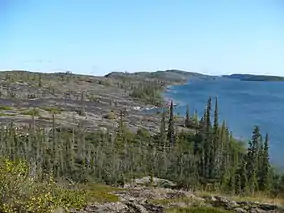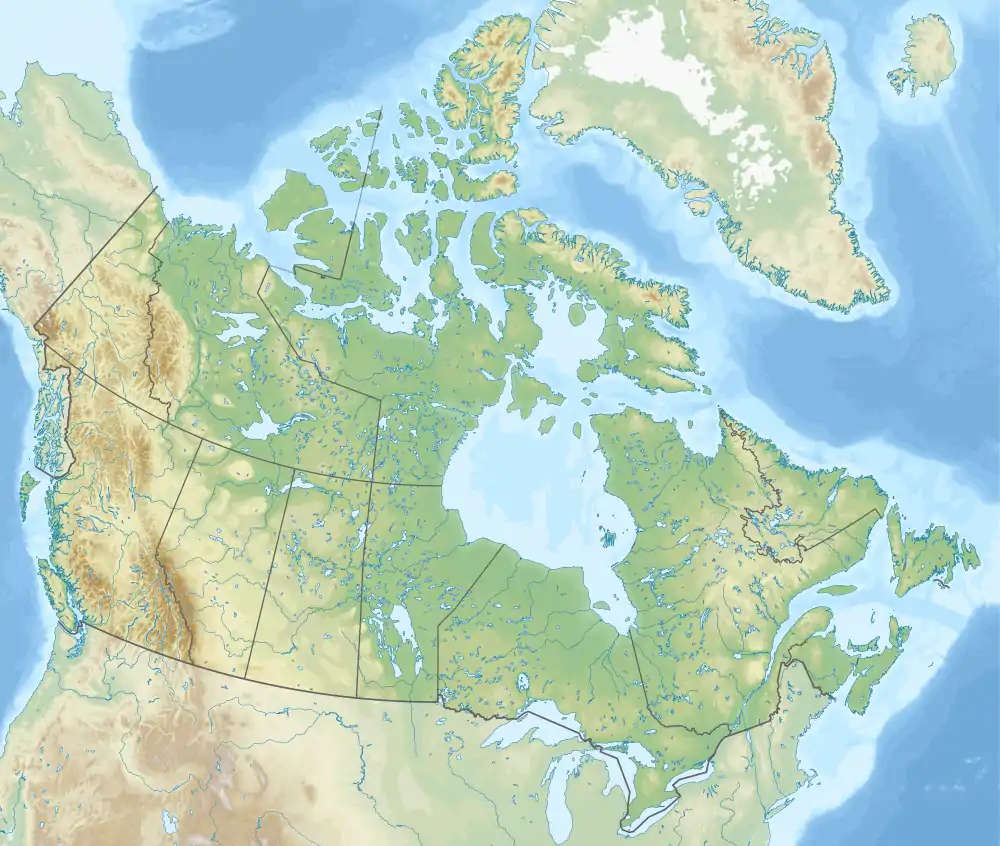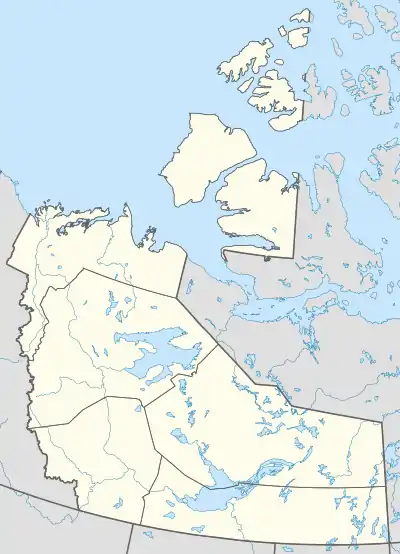Thaidene Nëné National Park Reserve
Thaidene Nëné National Park Reserve (from the Dene, this Chipewyan name means land of our ancestors[1]) is a protected area in the vicinity of the east arm of Great Slave Lake, located on the northern edge of the boreal forest of Canada in the North Slave Region of the Northwest Territories.[2] The National Park Reserve consists of a national park administered by Parks Canada and an adjacent protected area administered by the Government of the Northwest Territories. The current land withdrawal covers an area of approximately 33,690 km2 (13,008 sq mi).
| Thaidene Nëné National Park Reserve | |
|---|---|
 Utsingi Point | |
 Location of Thaidene Nëné  Thaidene Nëné National Park Reserve (Northwest Territories) | |
| Location | North Slave Region Northwest Territories Canada |
| Nearest city | Yellowknife |
| Coordinates | 62°30′N 111°00′W |
| Area | 14,305 km2 (5,500 sq mi) |
| Established | 21 August 2019 |
| Governing body | Parks Canada |
The area has been subject to interim land withdrawals by which "no new mining claims or oil and gas rights will be issued for the affected area" while decisions are being made.[3] Some areas of potentially high mineral content have been excluded from the proposals, such that certain industrial and commercial activities will likely be approved to continue in those areas.[3] Designation as a national park would prevent the expansion of uranium and diamond mines into the park's boundaries,[2] and works to protect caribou and pelt animals such as "lynx, wolf, red fox, wolverine, marten, moose and black bear".[1] Other mammals inhabiting this park reserve include Arctic fox, beaver, muskox, grizzly bear and barren-ground caribou.[4] The area features red granite cliffs, as well as "a spectacular array of peninsulas, canyons and waterfalls as the forests give way to northern tundra".[5] Various migratory bird species also stage and nest in the area, including ducks and songbirds.[6]
History
Consideration for the creation a 7,340 km2 (2,830 sq mi) national park in the region was withdrawn in 1970 under the Territorial Lands Act, but in 2001 the Łutsël K'é Dene First Nation (previously Snowdrift) re-considered the proposal.[7] Consultations for a feasibility study proceeded from 2002 to 2004, which drew the inclusion of the Métis Nation to the process.[8] By 2005, the Łutselk'e produced a Band Council Resolution "supporting consideration of a national park as part of a broader protection initiative for their traditional territory",[9] in cooperation with other Akaitcho First Nations. In 2006, the Łutselk'e Dene First Nation and the Minister of Environment and Minister Responsible for Parks Canada signed a Memorandum of Understanding which expanded the land withdrawal area for consideration for the national park by an additional 26,350 km2 (10,170 sq mi) and defined a process for working together on matters pertaining to establishing a national park.[10][11] Originally expected to be designated in 2009,[12] negotiations have yet to be finalized.
By 2014, the government of the Northwest Territories through the Northwest Territories Devolution Act took administrative control of the 33,690 km2 (13,010 sq mi) park study area, and by the following year initiated a "matrix of protected area designations" that included a scaled-down National Park Reserve of 14,000 km2 (5,400 sq mi) in combination with a range of territorial designations, conserving 75 percent of the 33,690 km2 (13,010 sq mi) area.[13] Public consultations on the smaller proposed boundaries finished in 2016. The federal government's 2016 budget named the Thaidene Nëné proposal in its allocation of funds to help the National Park Reserve to realization.[14]
On June 10, 2015, Parks Canada and the Northwest Territory Métis Nation negotiators reached an agreement in principle on most elements of an Impact and Benefit Agreement. The agreement is subject to internal review and consultation by both the NWTMN and Parks Canada.
The Government of Canada announced its proposed boundary for a national park reserve in the Thaidene Nëné area on July 29, 2015 and launched formal consultations on the boundary.[15]
On February 15, 2019, the Łutselk'e Dene First Nation voted to approve the creation of Thaidene Nëné National Park Reserve.[16] On 21 August 2019, an agreement was signed by Parks Canada, the Government of the Northwest Territories, and three First Nations (Lutsel K’e Dene First Nation, Deninu K'ue First Nation, and Yellowknives Dene First Nation) establishing a protected area consisting of a 14,305 km2 (5,523 sq mi) national park administered by Parks Canada, and a 12,220 km2 (4,720 sq mi) area administered by the territorial government that includes a wildlife conservation area.[17]
References
- "Nature Canada Applauds Federal Government's Renewed Commitment to National Park System". Nature Canada. October 16, 2006. Retrieved November 21, 2007.
- Gandhi, Unnati (November 21, 2007). "NWT to get new national park". The Globe and Mail. Retrieved November 21, 2007.
- "N.W.T.'s Ramparts gain interim protection". CBC News. November 15, 2001. Retrieved November 22, 2001.
- https://www.canadiangeographic.ca/article/four-things-know-about-thaidene-nene-canadas-newest-national-park-reserve
- Martin, Don (November 21, 2007). "Harper earns green stripes by protecting vast areas of northern land". The Calgary Herald. Archived from the original on November 23, 2007. Retrieved November 21, 2007.
- "The Pew Charitable Trusts applauds Canadian Boreal Forest protection". Boreal Songbird Initiative. October 13, 2006. Retrieved November 21, 2007.
- "State of Protected Heritage Areas 2001 Report". Parks Canada. 2001. Archived from the original on August 5, 2011. Retrieved November 21, 2007.
- "State of Protected Heritage Areas 2003 Report". Parks Canada. 2003. Archived from the original on January 1, 2013. Retrieved November 21, 2007.
- "STATE OF PROTECTED HERITAGE AREAS for the period ending March 31, 2005". Parks Canada. 2005. Retrieved November 21, 2007.
- "WWF-Canada Supports Dene Initiatives and Ambrose's Announcements for Protection in the Mackenzie Watershed". World Wildlife Fund. October 13, 2006. Retrieved November 21, 2007.
- "Canadian Boreal Initiative applauds agreement for a new northern National Park between Lutsel K'e Dene First Nation and Parks Canada". Canada Newswire. October 13, 2006. Retrieved November 21, 2007.
- "Ottawa, Dene agree to create vast national park". CBC News. October 14, 2006. Retrieved November 21, 2007.
- [http://www.pc.gc.ca/eng/progs/np-pn/cnpn-cnnp/thaidene-nene/chrono.aspx Archived 2016-04-04 at the Wayback Machine Proposed Thaidene Nëné National Park Reserve, Chronology, Parks Canada, 2015
- Budget 2016, Chapter 4-A Clean Growth Economy, Providing Free Access and Expanding the National Park System, Government of Canada, 2016
- https://www.pc.gc.ca/en/pn-np/cnpn-cnnp/thaidene-nene/chrono
- "Lutselk'e votes to support creation of Thaidene Nene National Park Reserve". CBC News. February 19, 2019. Retrieved August 21, 2019.
- Blake, Emily (August 20, 2019). "Thaidene Nëné National Park Reserve becomes N.W.T.'s newest protected area". CBC News. Retrieved August 21, 2019.